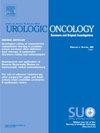Neoadjuvant chemotherapy prior to radical nephroureterectomy: Survival outcomes and recurrence patterns by pathologic node status
IF 2.3
3区 医学
Q3 ONCOLOGY
Urologic Oncology-seminars and Original Investigations
Pub Date : 2025-03-24
DOI:10.1016/j.urolonc.2025.03.001
引用次数: 0
Abstract
Purpose
To evaluate survival outcomes and recurrence patterns by pathologic nodal status in upper tract urothelial carcinoma (UTUC) patients receiving neoadjuvant chemotherapy (NAC) prior to radical nephroureterectomy (RNU) and lymph node dissection (LND).
Materials and Methods
Using the international ROBUUST 2.0 database, a retrospective analysis of UTUC patients who underwent robotic/laparoscopic RNU+LND±NAC was performed. Patients were stratified by NAC and pathologic nodal status into pN0, ypN0, pN+, and ypN+ subgroups. Overall (OS), metastasis-free (MFS), and urothelial recurrence-free survivals (RFS) were compared using Kaplan-Meier curves and multivariable Cox regression modeling.
Results
The cohort included 883 patients (15% received NAC). 212 (24%) patients had (y)pN+ disease. Median follow-up was 19 months. Compared to pN+ patients, ypN+ patients had significantly worse 1- (64% vs. 72%), 3- (40% vs. 54%), and 5-year (20% vs. 31%) OS rates. Node-negative patients had similar OS, irrespective of NAC treatment (1-year: 94%; 3-year: 77%–82%). At 1 year, all ypN+ patients had metastases, while 13% of pN+ patients remained metastasis-free. Among ypN+ patients, 89% experienced nodal/regional or distant metastases as the site of initial recurrence, compared to 39% of pN+ patients. Initial nodal/regional or distant metastases occurred in 42% and 18% of ypN0 and pN0 patients, respectively.
Conclusion
ypN+ patients have worse survival compared to pN+ patients. Recurrence patterns differ by nodal and NAC status, with ypN+ patients having a significantly higher incidence of nodal/regional or distant metastases as the initial site of recurrence. These survival outcomes and recurrence patterns differences may have important surveillance and treatment implications.
根治性肾输尿管切除术前的新辅助化疗:生存结果和病理淋巴结状态的复发模式。
目的:通过病理淋巴结状态评估上尿路上皮癌(UTUC)患者在根治性肾输尿管切除术(RNU)和淋巴结清扫(LND)前接受新辅助化疗(NAC)的生存结局和复发模式。材料和方法:使用国际robust2.0数据库,回顾性分析行机器人/腹腔镜RNU+LND±NAC的UTUC患者。根据NAC和病理淋巴结状态将患者分为pN0、ypN0、pN+和ypN+亚组。采用Kaplan-Meier曲线和多变量Cox回归模型对总生存率(OS)、无转移生存率(MFS)和尿路上皮无复发生存率(RFS)进行比较。结果:该队列包括883例患者(15%接受NAC)。212例(24%)患者患有(y)pN+疾病。中位随访时间为19个月。与pN+患者相比,ypN+患者的1-(64% vs。72%), 3-(40% vs。54%), 5年(20% vs。31%) OS率。淋巴结阴性患者的OS相似,与NAC治疗无关(1年:94%;3年:77% - -82%)。1年后,所有ypN+患者发生转移,而13%的pN+患者仍无转移。在ypN+患者中,89%的患者经历了淋巴结/区域或远处转移作为初始复发部位,而pN+患者的这一比例为39%。原发性淋巴结/局部或远处转移分别发生在42%和18%的ypN0和pN0患者中。结论:ypN+患者的生存期较pN+患者差。复发模式因淋巴结和NAC状态而异,ypN+患者的初始复发部位为淋巴结/区域或远处转移的发生率明显更高。这些生存结果和复发模式的差异可能具有重要的监测和治疗意义。
本文章由计算机程序翻译,如有差异,请以英文原文为准。
求助全文
约1分钟内获得全文
求助全文
来源期刊
CiteScore
4.80
自引率
3.70%
发文量
297
审稿时长
7.6 weeks
期刊介绍:
Urologic Oncology: Seminars and Original Investigations is the official journal of the Society of Urologic Oncology. The journal publishes practical, timely, and relevant clinical and basic science research articles which address any aspect of urologic oncology. Each issue comprises original research, news and topics, survey articles providing short commentaries on other important articles in the urologic oncology literature, and reviews including an in-depth Seminar examining a specific clinical dilemma. The journal periodically publishes supplement issues devoted to areas of current interest to the urologic oncology community. Articles published are of interest to researchers and the clinicians involved in the practice of urologic oncology including urologists, oncologists, and radiologists.

 求助内容:
求助内容: 应助结果提醒方式:
应助结果提醒方式:


